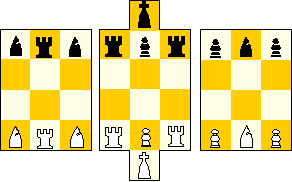Cube+
Introduction
In Late November, Jim Aikin sent us the following email:
Here are two entries for your 38-square competition -- AMOEBA and CUBE+. Neither of them has been tested in play, but I tried to make them both playable. Each has a couple of variants of its own.
If anybody tries out either game, I'd appreciate receiving a copy of the game so I can study it. Also, if anybody wants to try playing either of them with me by email, I'd be happy to give it a try.
The Board

This 3D variant is played on a board that is basically 4x3x3, with the long axis oriented so that it points toward the players. Call the horizontal layers A (the top), B, and C, the vertical faces with a row orientation 1 through 4, and the vertical side-faces (column orientation) a, b, and c. There are two additional squares -- B0b and B5b -- extending from the end faces.
Each player starts the game with 10 pieces: a king, three pawns, three rooks, and three bishops. None of them move in exactly the expected manner, however. The names are merely for convenience. Here is the initial arrangement:
Top layer (A) 4: b r b 3: - - - 2: - - - 1: B R B |
Middle layer
(B)
5: k
4: r p r
3: - - -
2: - - -
1: R P R
0: K
|
Bottom layer
(C)
4: p b p
3: - - -
2: - - -
1: P B P
|
The Rules
There are two ways to win Cube+: Either checkmate the opposing king, or move a piece into the opponent's extension square (the one on row 0 or 5) without it being subject to immediate capture.
The rook moves exactly one square left or right, forward or back, or up or down. It captures as it moves.
The king moves and captures in the same manner as the rook, with the usual prohibition on moving into check.
The bishop moves exactly one square diagonally within any two-dimensional plane, but not along the 3D diagonals (from B3b to B4a, B4c, B2a, or B2c; A3a, A3c, A4b, or A2b; or C3a, C3c, C4b, or C2b; but NOT from B3b to A4a, etc.). The bishop captures as it moves. Note that one player starts the game with two white bishops and one black bishop, the other with two black bishops and one white bishop. This might lead to a fairly interesting strategic imbalance.
The pawn moves like a Cube+ rook and captures like a Cube+ bishop. There is no pawn promotion, and pawn movement exhibits no directional bias; the pawn can move or capture forward or backward, up or down. Here is the pawn's range of movement starting from B3b (m = move, c = capture):
Layer A 4: - c - 3: c m c 2: - c - 1: - - - |
Layer B 5: - 4: c m c 3: m p m 2: c m c 1: - - - 0: - |
Layer C 4: - c - 3: c m c 2: - c - 1: - - - |
Variants
- When a piece is captured, it returns immediately to the board in the player's extension square, if that square is vacant. If the extension square is occupied, the piece is lost. The idea behind this variant is to extend what might otherwise be a fairly short game and give rise to more unusual tactical formations.
- Instead of capturing like a Cube+ bishop, the pawn captures along the 3D diagonals:
- The pawn can move exactly one square in any direction (26 possible squares from a central square), making it the most mobile piece. However, it must capture a bishop by moving in a rooklike direction, and capture a rook by moving in a bishoplike direction. Thus it can threaten a bishop without being threatened by the bishop, or threaten a rook ditto, but cant capture either a rook or a bishop when threatened by same. A pawn can only threaten the king or capture another pawn along the 3D diagonals.
Layer A 4: c - c 3: - m - 2: c - c 1: - - - |
Layer B 5: - 4: - m - 3: m p m 2: - m - 1: - - - 0: - |
Layer C 4: c - c 3: - m - 2: c - c 1: - - - |
(c) 1997 Jim Aikin
Play It!
Use Zillions of Games to play this game! If you have Zillions of Games installed, you can download this game and play it.Written by Jim Aikin. HTML conversion and graphic by David Howe.
This is an entry in the Contest to make a chess variant on a board with 38 squares.
WWW page created: December 9, 1997.